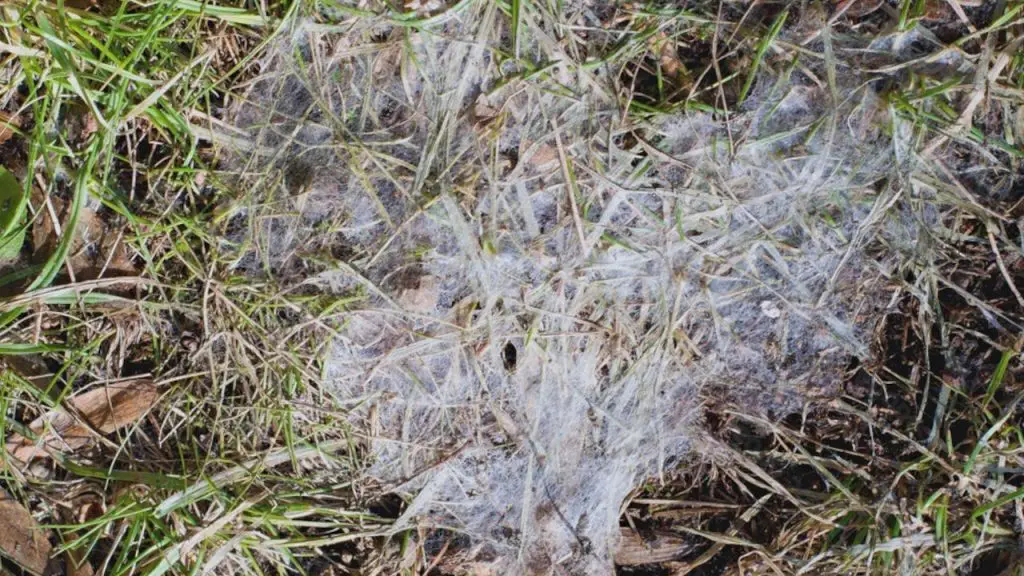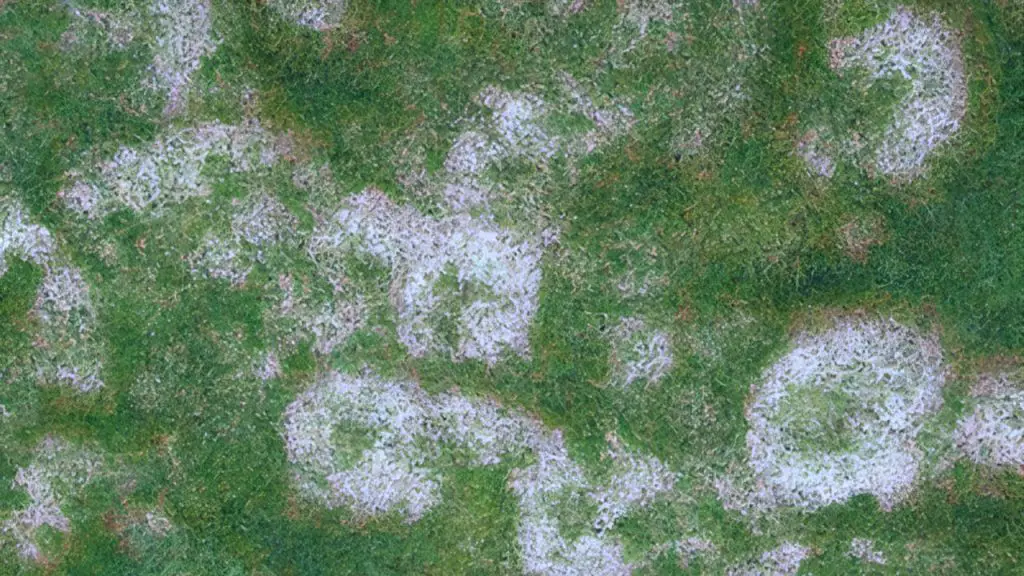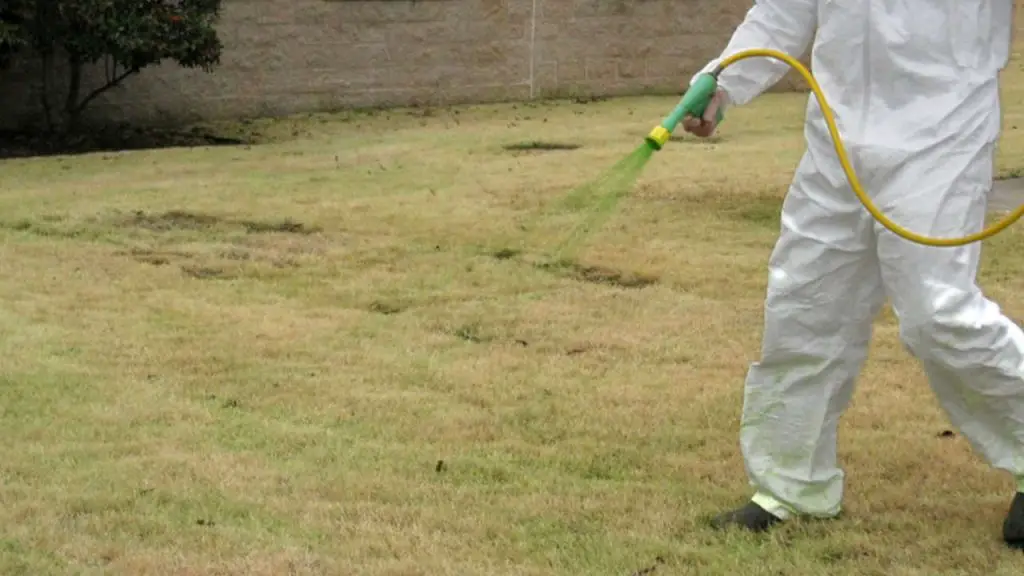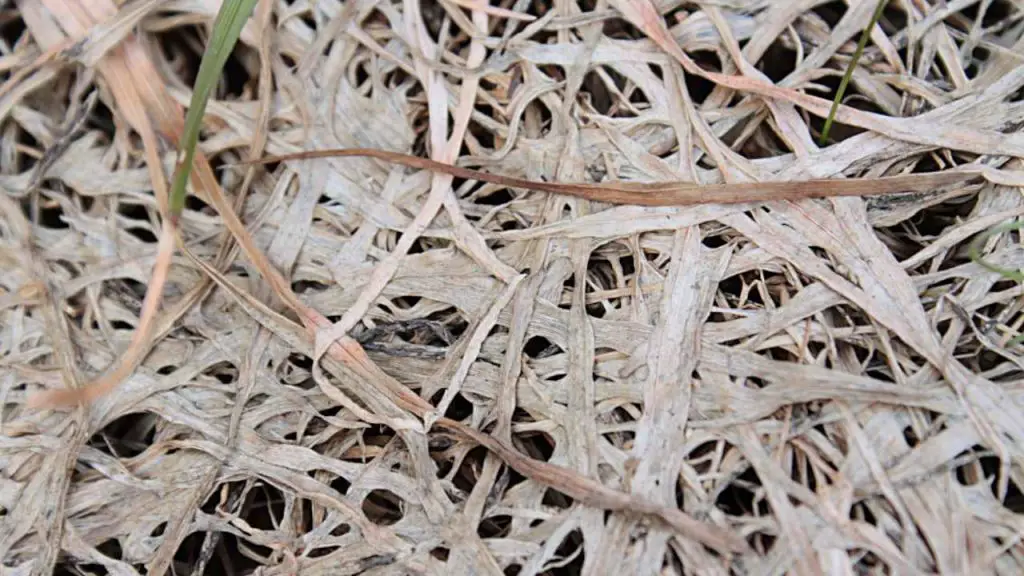Snow Mold on Grass | Treating Pink and Gray Snow Mold on Lawn
The winter months are very important for the health of your lawn. Snow mold on grass is something that you don’t want to happen.
Below, we look into the intricacies of pink and gray snow mold, two fungal diseases that covertly compromise the health of your turfgrasses during the icy winter months. From identifying the initial signs of these lawn infections to understanding their lifecycle and implementing strategic control methods, we’ll navigate through each pivotal step together.
We will look to cover the following aspects:
- Identifying Snow Mold: Spotting the subtle signs before they escalate.
- Understanding the Fungi: A closer look at Microdochium nivale and Typhula incarnata.
- Preventive Strategies: Ensuring your lawn is fortified against future invasions.
- Treatment Tactics: Nurturing your grass back to its robust self post-invasion.
What is Snow Mold
Snow mold, in fact, is an overarching term that covers two different lawn infections gray snow mold and pink snow mold (fusarium patch) These lawn diseases generally occur during the winter and spring seasons.
Snow mold grows on snow or frost and then moves to grass blades. It causes brown or purple patches or pink circles depending on the infection and in some cases, grasses, particularly in the case of pink snow mold, even die. Furthermore, pink snow mold is capable of existing unseen throughout the summer months and thus this fungus has the potential to do long-term damage to your grass.
What is Snow Mold on Grass?
Snow molds are fungal diseases that thrive under snow causing damage to grass. They can occur at any time but are generally more noticeable after periods of standing snow. Depending on the variety they can be one of the most damaging diseases for turfgrasses and can be difficult to control. It is found most frequently during autumn, winter, and early spring, but attacks can occur at any time of the year. If they take hold they can be very destructive and they may be very difficult to treat once established.
There are two distinct varieties pink snow mold and gray snow mold. The pink variety is more common than the grey one. It usually occurs in the late winter months when a covering of snow seals in heat and moisture underneath it, producing a perfect environment for fungal growth to flourish.
This kind of snow mold (Microdochium nivale), which is also referred as microdochium patch tends to do more harm than its grey cousin since it may also kill grassroots and crowns, rather than simply the blades, as it grows. Furthermore, since it is capable of living unseen throughout the summer months, this illness has the potential to do long-term damage to your grass.
What causes snow mold on grass?
Snow mold on grass can come in two distinct variations, gray snow mold caused by the Typhula pathogen and pink snow mold caused by Microdochium nivale pathogen. These two fungi are incredibly resilient and can survive in temperatures as low as -5 degrees Fahrenheit but is at their most active between 32 and 60 degrees Fahrenheit, depending on the variety. The fungi thrive in wet conditions, especially where snow has insulated wet grass for a prolonged period.
Gray Snow Mold

Typhula incarnata or other Typhula species are responsible for the development of grey snow mold. Right after the snow melts, circular areas of the injured lawn may be seen in various shades of yellow to white.
Patch sizes range from small to broad, and they may overlap to wreak havoc on huge sections of lawn. Sclerotia (yellowish fibers) are produced by the fungus and grow to a dark-brown to black hue when fully matured. These fibers are plainly apparent and remain throughout the summer and into the late autumn. After the standing snow cover has melted away, these fibers spread and begin colonizing grass blades again about four to six weeks later.
Gray snow mold infections usually happen most during the winter and or early spring months. The ideal temperature for the fungi to thrive is between 32 and 40 degrees Fahrenheit. Gray snow mold infections very seldom cause the grass to die, thus treatment is not always necessary.
Pink Snow Mold

Pink snow mold can be more problematic as it is a far more destructive infection than gray snow mold because it attacks the roots as well as the grass blade. This fungus, however, is active in a much narrower temperature range between 32-60 degrees F. and in moist circumstances.
The pink snow mold variety is produced by the fungus Microdochium nivale, which creates broadly circular-shaped bleached patches varying in size from one to six inches in diameter. Initially, the patch will seem reddish and water-soaked, but it will eventually become a pinkish-white color with a reddish border as the water evaporates.
Grass Susceptible to Snow Mold
Snow mold is most often seen in cool-season grasses, which are more sensitive to the disease. It particularly affects grass species such as annual meadow grass, but it may also be problematic on some types of bentgrasses, fescues, and perennial ryegrass.
The presence of snow mold fungus is associated with the capacity of most species to withstand freezing temperatures and ice cover. In order for a grass plant to be properly acclimated and ready for the winter, it must have stopped growing, stored some extra sugar for the winter, produced anti-freeze proteins within its cells, and modified its cells’ membranes to make them more stable when subjected to freezing and thawing conditions.
Warm temperatures throughout the winter might cause the lawn to trigger de-acclimatization causing infection. The degree to which turfgrass species are vulnerable to such warm periods varies from one species to the next.
Grass species with better genetic resistance to snow mold (both gray and pink) than other turfgrass varieties include Browntop (Colonial bent), Chewings red fescue, and Velvet bentgrass. Whilst none of these grasses are completely immune to snow mold they have a much better they are most winter stress-resistant grass varieties available.
How to Control Snow Mold
The treatments used to cure the harm caused by these two forms of mold are substantially different in the spring. Pink Snow mold may have to be treated with a fungicide (see below) if the affected area is large enough. When dealing with Gray Snow Mold, carefully rake the afflicted portions of the grass to aid drying and prevent future development. It is not usually suggested to use fungicides. It is possible that some reseeding may be required to fill up areas that have been severely damaged.
Treating Pink Snow Mold on Lawn
Treatments with fungicides may be required to control pink snow mold on newly planted lawns or on lawns that have already had mold infestations.
Using Fungicide to Treat Snow Mold (Chemical Control)

When battling extensive snow mold a solitary active ingredient seldom is able to deal with the problem. This typically necessitates the amalgamation of three or more active ingredients to establish satisfactory control. Conversely, under milder snow mold presence, the incorporation of merely one or two active ingredients generally suffices particularly against gray and speckled snow mold.
Once the spring sun melts away the snow, these diseases cease their activity. Accelerating recovery becomes feasible through a gentle touch of fertilization and strategic verticutting (dethatching).
The most common fungicide used to treat snow mold infections is trifloxystrobin. The fungicide may be applied throughout the year, with the exception of when the grass is frozen or when there is a drought. Because there is a possibility of resistance developing in the fungal population, the product should not be sprayed more than twice a year and should be used in combination with other control measures whenever possible.
Other fungicides that are used contain chlorothalonil, fluazinam, and mancozeb. In certain states and countries, these may be limited to only professional applications. Your local garden center should be able to advise.
Fungicides to Treat or Prevent Snow Mold
| Fungicide | Application Rate Guide | Frequency | Notes |
|---|---|---|---|
| Propiconazole 14.3 | 3-4 ounces per 1,000 sq. ft. | Before the first snowfall and as needed | Preventative manner preventative manner |
| Patch Pro | 2-4 ounces per 1,000 sq. ft. | Before the first snowfall and every 30-90 days | Broad-spectrum preventative manner that can be used to control snow mold. |
| Chlorothalonil | 0.5 to 1 lbs per 1000 sq ft | Before the first snowfall | Broad-spectrum preventative manner that can be used to control snow mold. It is a preventative treatment |
| Iprodione | 0.5 to 1 lb per 1000 sq ft | Repeat 7-14 Days when environmental conditions are conducive to the fungus | Effective against various types of molds, including snow mold |
| Pyraclostrobin | 0.125 to 0.25 lb per 1000 sq ft | Shortly prior to the expected snow cover | Broad-spectrum preventative manner that can be used to control snow mold. |
| Tebuconazole | 0.125 to 0.25 lb per 1000 sq ft | Shortly prior to the expected snow cover | Broad-spectrum preventative manner that can be used to control snow mold. |
| Polyoxin D Zinc Salt | 0.5 oz per 1,000 sq ft | Repeat 7-14 Days when environmental conditions are conducive to the fungus1 | Controls snow mold and is often used on golf courses |
Note: Application rates and frequencies are guides only and will vary depending on circumstances. Always follow the instructions on the product’s label and if in doubt seek professional help or contact your Local Extension office.
Cultural Control (Nonchemical Control)
Improve lawn aeration and drainage to ensure that the grass dries out quickly after dew or rains. To help this process, a mix of scarifying, spiking, and hollow- or solid tining may be used.
In addition, by trimming down overhanging trees or bushes, you may improve the overall airflow across your lawn helping the drying-out process. If there is a particularly heavy dew this should be removed first thing in the morning using a switch (a long, bendable rod) or a bamboo cane.
Verticutting
One particularly import measure is to remove thatch build-up from the lawn. Thatch is a layer of dead grass, roots, and debris that accumulates between the soil surface and the live grass above.
Key Points about Verticutting:
- Thatch Removal: Verticutting helps to remove excess thatch, which can harbor pests and diseases and restrict water and nutrient penetration into the soil.
- Grass Health: By removing thatch, verticutting allows grass to breathe better, take up more nutrients, and grow more robustly.
- Soil Aeration: The process also helps to aerate the soil, providing better oxygen flow to the grass roots and improving overall turf health.
- Seedbed Preparation: Verticutting can also be used to prepare the seedbed for overseeding by creating grooves in the soil that help to ensure good seed-to-soil contact.
- Enhanced Appearance: It can enhance the overall appearance and health of the lawn by encouraging denser and more even grass growth.
Application in the Context of Snow Mold:
In the context of snow mold recovery, verticutting can be particularly beneficial because:
- It helps to remove matted, dead grass affected by the mold, allowing healthy grass to breathe and grow.
- It can break up the mycelium (fungal threads) of the snow mold, reducing its impact.
- It creates space for new grass to grow when overseeding the affected areas.
Finally, you should avoid using excessive dosages of nitrogen fertilizer in the late summer or fall – instead, might be preferable to use a special autumn lawn feed designed specifically for your grass.
Prevention of Snow Mold Disease

Prevention is always preferable to having to cure a problem like snow mold. Unfortunately, it is impossible to completely eliminate the possibility of snow mold infections but you can take numerous steps to ensure that it is less likely
Cultivation practices, cultivar selection, and garden cleanliness should be the primary lines of defense against snow mold fungus. your lawn care maintenance program is the best place to start.
Due to the fact that taller grass tends to mat more easily when coated in snow, pink snow mold is more frequent in grasses that are two inches or more in height. The best course of action is to maintain a healthy lawn and maintain regular mowing well into the fall months. It is advisable that the last cut of your lawn before winter leaves the grass short.
Grass Species Resistant to Snow Molds
| Grass Species | Season | Resistance Level | Additional Notes |
|---|---|---|---|
| Fine-leaved Fescues | Cool Season | High | – |
| Tall Fescues | Cool Season | High | – |
| Delray Perennial Ryegrass | Cool Season | Moderate to High | – |
| Chewings Fescue | Cool Season | Moderate to High | Generally more resistant to summer patch. |
| Red Fescue | Cool Season | Moderate to High | – |
| Kentucky Bluegrass (with tall and fine fescue) | Cool Season | Moderate | Known to be susceptible to snow mold when standalone. |
| Smooth Stalked Meadowgrass (Poa pratensis) | Cool Season | High | Especially in severe winter climates. |
| Prostrate Meadow Grass (Poa supina) | Cool Season | High | Especially in severe winter climates. |
| Velvet Bent (Agrostis canina) | Cool Season | High | Especially in severe winter climates. |
| Fine Fescue | Cool Season | High | Hard fescue cultivars are particularly resistant to snow mold. |
| Creeping Red Fescue | Cool Season | Medium | Moderately resistant to snow mold. |
| Kentucky Bluegrass | Cool Season | Low | On its own is known to be susceptible to snow mold. |
The table provides a list of common species and their resistance levels. It’s essential to note that resistance can vary between different cultivars within a species. You also need to consider other factors such as climate, soil type, and maintenance practices when choosing a grass species for your lawn
Allowing the Grass to Breathe
Snow mold often affects areas, where the soil is very compact good aeration of the lawn, especially in these areas, can be very important. This can be done with a garden fork or can be done with aerators either solid or hollow tines.
As well as helping deal with snow mold infections, reducing and keeping thatch away from your lawn is also an important preventative measure as it allows the grass to breathe. Mulch and leaves laid down in thick layers provide the ideal setting for the growth of pink snow mold. This can be done by scarifying your lawn.
If you are planning to reseed parts of your lawn consider reseeding with more fungi-resistant grass species and turfgrass varieties.
Fertilization
It is also important to keep an eye on the nitrogen levels in your soil. Too little can result in other lawn fungi such as Dollar Spot and Red Thread taking hold, and too much can cause snow patch to become a problem
There are other sensible steps that you can take including not exacerbating the infection by not properly cleaning your garden tools. During the foliar blight stage, mowing unfortunately is a very efficient way of spreading this fungus across the field. If you are using a professional lawn care company ensure they have properly cleaned their equipment and that you don’t suffer cross infections from other jobs.
Finally, if you do experience snowfall try to avoid piling the snow into mounds on the grass if you are clearing pathways or drives.
Case Studies
#1 Case Study: Management of Snow Mold in Residential Lawns
Introduction
In the transitional period from winter to spring, homeowners in various zones, often encounter snow mold. This case study explores a real-world scenario wherein a homeowner, confronted with a lawn besieged by snow mold, sought community advice and navigated through the challenge with strategic actions and preventive measures.
Approach
Immediate Mitigation
Upon discovering the pervasive snow mold, a concerned homeowner sought immediate advice, pondering:
Is intervention required for snow mold, or will it naturally dissipate with warming temperatures?
We looked to give the gardener straightforward advice and an initial mitigation approach:
A light raking to facilitate airflow across the lawn can be an effective immediate response to managing snow mold.
Root Cause Analysis and Preventive Strategies
Seeking a deeper understanding of the underlying causes, the homeowner queried:
Could the cause be attributed to excessive dead material, or are there other factors at play?
We then looked to give the gardener more in-depth insights into causative factors while emphasizing a preventive approach:
The emergence of snow mold can be attributed to pre-existing fungi on the lawn and specific weather conditions.
Preventive strategies, beginning in the fall, such as the application of specific lawn fungicides and meticulous pre-winter lawn care—including debris clearance and maintaining short grass length—can be pivotal.
Gentle Recovery and Future Vigilance
The advice underscored the importance of gentle recovery and ongoing vigilance:
While typically not a severe issue, gentle raking to allow the lawn to breathe, coupled with gradually increasing temperatures, will aid in the dissipation of snow mold. It’s crucial to employ gentle recovery efforts to avoid damaging the winter-weary turf while facilitating its recovery.
Take Aways
1. Immediate Action for Mitigation
- Aeration: Gentle raking facilitates airflow, crucial for mitigating the spread and impact of snow mold.
2. Understanding and Addressing Root Causes
- Fungal and Environmental Factors: Recognizing pre-existing fungi and weather conditions as pivotal contributors to snow mold manifestation.
- Preventive Lawn Care: Acknowledging the importance of meticulous lawn maintenance in fall to preemptively mitigate spring outbreaks.
3. Proactive Prevention Strategies
- Utilization of Fungicides: Employing fungicides in late fall as a preventive measure against potential fungal outbreaks.
- Optimal Lawn Maintenance: Ensuring thorough debris clearance and maintaining appropriate grass length before winter sets in.
4. Gentle and Strategic Recovery
- Tender and Considerate Care: Employing gentle recovery efforts to avoid damaging the winter-weary turf while facilitating its recovery.
5. Leveraging Community Knowledge and Resources
- Community Engagement: Utilizing community forums and resources for practical advice and shared experiences.
- Resource Utilization: Employing available resources, such as instructional videos, for additional insights and strategies.
Note
This case study underscores the significance of a two-pronged approach in managing snow mold: immediate, gentle mitigation efforts and strategic, preventive measures. Through community engagement and the application of expert advice, the homeowner was able to navigate through the challenge, safeguarding the lawn while acquiring knowledge and strategies for future preventive care and management.
Hopefully, this case study can serve as a guide for homeowners encountering similar problems with snow mold. It emphasizes the importance of understanding, strategic action, and preventive care in managing snow mold effectively.
